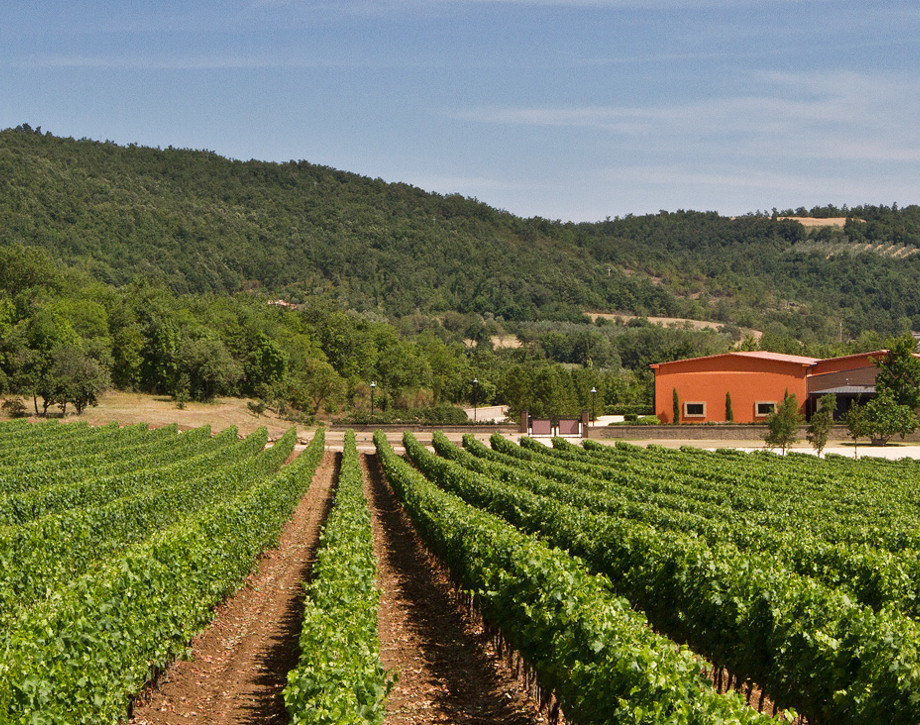Aleatico

Climate
The 2009 vintage was characaterized by a winter of mild tempratures and abundant rainfall which contributed, during the first half of April, to an excellent bud break. Between Aèrl 20th and May 15th temperatures were notably lower than seasonal averages; this unusual cold spell slowed down the development of the vegetation which started up, however, once again, with the warmth of late May. Bud set, as usual, took place in early June. Vegetative growth and development continued in a positive manner thanks to an early summer which was somewhat rainy for the season. This rainfall allowed the vines to maintain a balanced vegetation even during the hot month of August, guaranteeing a complete color change of the grapes. Good temperature swings between daytime heat and nighttime coolness during the month assisted in a steady ripening and to healthy and perfectly intact grapes at the moment of picking. The harvest itself, which began in late September, took place under warm and dry weather which allowed the grapes to be picked at optimal ripeness levels. The resulting wine is balanced, sweet, and intense.
Vinification
The grapes, picked when perfectly ripe, were divided into two parts: the first was immediately fermented, the other placed in specially designed drying areas, dry and well ventilated, in order to increase their aromatic and structural concentration. The winemaking process, nonetheless, was exactly the same for both: after destemming and pressing, the must underwent a week-long cold pre-fermentation maceration on its skins which assisted the extraction of the complex aromatic gamut, of the typical color, and of the balanced, intense structure. The must was then run off its skins and fermented at low temperatures, below 20° centigrade (68° Fahrenheit). Once the desired level of residual sugar was reached, the fermentation was blocked by a sudden lowering of the fermentation temperature. The wine was aged at low temperatures until its bottling.
Historical data
The Aldobrandesca farm is situated near the historic hamlet of Sovana in southern Tuscany. The first vintage to be produced was the 1997. This wine is distinguished by its personality, its drinking pleasure, and by the typical aromatic richness of its nose and palate.
Tasting Notes
The wine shows intense notes of roses, tea, ripe plums, and strawberries. On the palate it is ample, full, velvety in texture, and with an aftertaste dominated by the typical fruit and floral notes of its grape.

The Wine
Aleatico, a very old grape variety and also the name of a traditional Tuscan sweet dessert wine, develops a unique varietal expression in this area that stands out for its strong identity and a soft, balanced palate. Part of the harvest is vinified immediately while the other part is left to air dry to concentrate aromas. The result is a pleasant expression of freshness and structure while preserving the richness of the variety’s typical floral and spicy aromas.

Climate
The 2009 vintage was characaterized by a winter of mild tempratures and abundant rainfall which contributed, during the first half of April, to an excellent bud break. Between Aèrl 20th and May 15th temperatures were notably lower than seasonal averages; this unusual cold spell slowed down the development of the vegetation which started up, however, once again, with the warmth of late May. Bud set, as usual, took place in early June. Vegetative growth and development continued in a positive manner thanks to an early summer which was somewhat rainy for the season. This rainfall allowed the vines to maintain a balanced vegetation even during the hot month of August, guaranteeing a complete color change of the grapes. Good temperature swings between daytime heat and nighttime coolness during the month assisted in a steady ripening and to healthy and perfectly intact grapes at the moment of picking. The harvest itself, which began in late September, took place under warm and dry weather which allowed the grapes to be picked at optimal ripeness levels. The resulting wine is balanced, sweet, and intense.
Vinification
The grapes, picked when perfectly ripe, were divided into two parts: the first was immediately fermented, the other placed in specially designed drying areas, dry and well ventilated, in order to increase their aromatic and structural concentration. The winemaking process, nonetheless, was exactly the same for both: after destemming and pressing, the must underwent a week-long cold pre-fermentation maceration on its skins which assisted the extraction of the complex aromatic gamut, of the typical color, and of the balanced, intense structure. The must was then run off its skins and fermented at low temperatures, below 20° centigrade (68° Fahrenheit). Once the desired level of residual sugar was reached, the fermentation was blocked by a sudden lowering of the fermentation temperature. The wine was aged at low temperatures until its bottling.
Historical data
The Aldobrandesca farm is situated near the historic hamlet of Sovana in southern Tuscany. The first vintage to be produced was the 1997. This wine is distinguished by its personality, its drinking pleasure, and by the typical aromatic richness of its nose and palate.
Tasting Notes
The wine shows intense notes of roses, tea, ripe plums, and strawberries. On the palate it is ample, full, velvety in texture, and with an aftertaste dominated by the typical fruit and floral notes of its grape.

Fattoria Aldobrandesca
The Fattoria Aldobrandesca estate is located in the southern part of Tuscan Maremma, in the center of what is known as “the Etruscan Tuff zone”. Maremma is often associated with its coastline, flat lands, pine tree forests, horses and local cowboys called “butteri”. The Fattoria Aldobrandesca estate is in rural Maremma located inland in an area known as the Tuff Area. Ancient civilizations built fascinating medieval fortresses and settlements on steep tuff bluffs that today are open-air museums. Small characteristic towns carved out of tuff stone in this area are Pitigliano, Sorano and Sovana. The vineyards rise on the slopes of a spur of tuff where the hilltop town of Sovana is located, surrounded by a beautiful landscape of incredible natural beauty, rich in architectural heritage.

Soil
Open terrain, volcanic in origin with tufaceous subsoils.
















